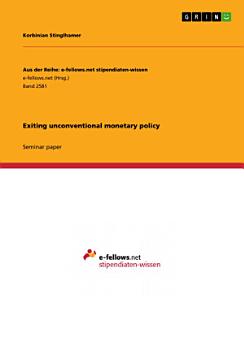Exiting unconventional monetary policy
2017년 10월 · Aus der Reihe: e-fellows.net stipendiaten-wissen 2581권 · GRIN Verlag
eBook
19
페이지
family_home
적용 가능
info
report검증되지 않은 평점과 리뷰입니다. 자세히 알아보기
eBook 정보
Seminar paper from the year 2016 in the subject Economics - Finance, grade: 1,0, University of Wisconsin-Madison (Economics), course: The Financial System, language: English, abstract: The paper analyzes the unconventional monetary policies that were implemented by the Federal Reserve Bank, the Bank of England, the European Central Bank, and the Bank of Japan during their post-crisis transitions. Next, potential challenges involved in the exit will be analyzed. During the financial crisis many central banks in the world implemented “unconventional monetary policy” measures, such as balance-sheet policies, forward guidance, and negative interest rates. Once the financial system stabilizes, the difficult process of returning back to conventional monetary policy begins. For this reason, this paper analyzes the unconventional monetary policies during post-crisis transitions and potential challenges involved in the exit. The analysis suggests that a transition from unconventional monetary policies should be accomplished smoothly, without exceeding inflation, harming economic recovery, or destabilizing financial markets. Furthermore, the analysis suggests to make use of forward guidance in order to prepare the market for the exit and to increase its potential speed. However, the optimal exiting policy depends largely on present and future economic conditions of the respective currency region. In order to analyze these conditions and determine the ideal exiting strategy for each central bank, further investigations need to be done.
이 eBook 평가
의견을 알려주세요.
읽기 정보
스마트폰 및 태블릿
노트북 및 컴퓨터
컴퓨터의 웹브라우저를 사용하여 Google Play에서 구매한 오디오북을 들을 수 있습니다.
eReader 및 기타 기기
Kobo eReader 등의 eBook 리더기에서 읽으려면 파일을 다운로드하여 기기로 전송해야 합니다. 지원되는 eBook 리더기로 파일을 전송하려면 고객센터에서 자세한 안내를 따르세요.










